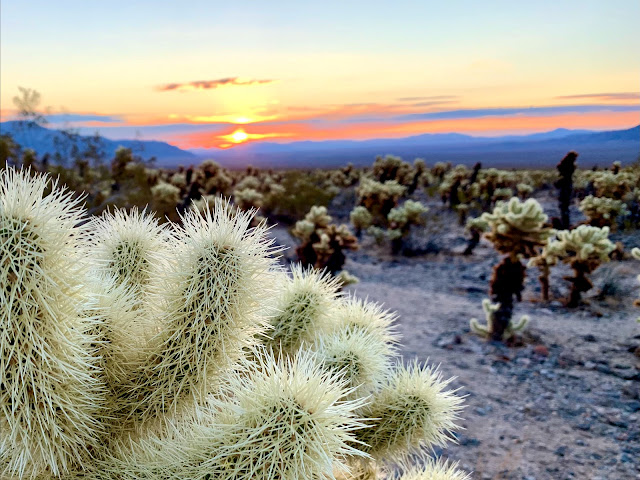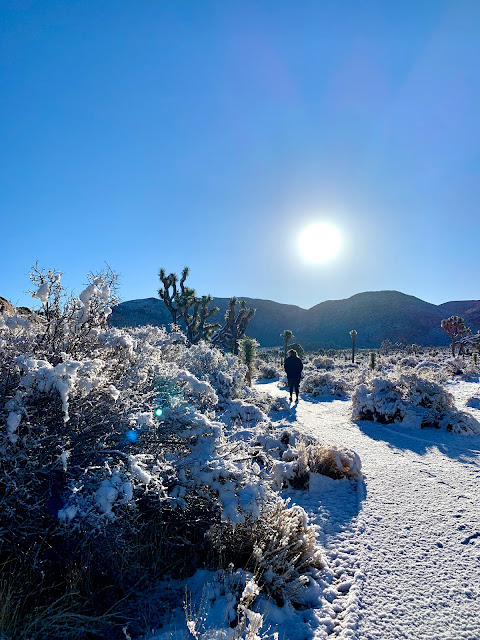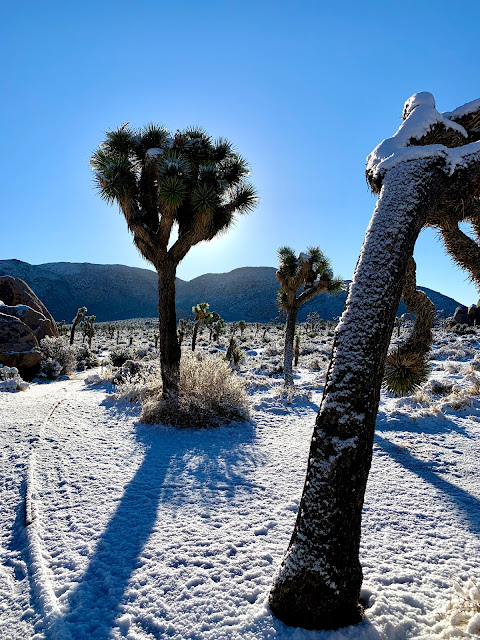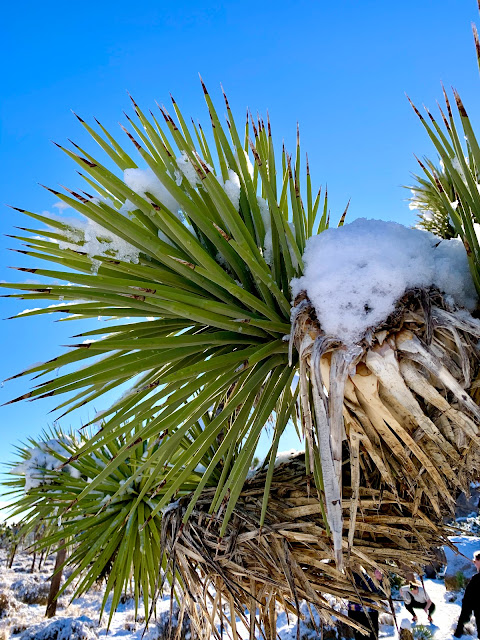Well, I've been (positively) peer pressured into blogging again (hi, Priscilla) and our four day trip to southern California this weekend feels like as good a reason as any to get back in the saddle.
In celebration of friend and quarantine pod-mate Hannah's 30 years on earth, we booked a house in Yucca Valley, CA, between Joshua Tree National Park and Palm Springs. Figuring we'd get some of that famous SoCal sun, we booked a house with a pool and hot tub overlooking the valley. What we (or at least I) didn't account for was the fact that its freaking cold in the high desert in March! Thankfully that pool was heated.
The drive down to Yucca Valley took about 8 hours with frequent stops for the 4 humans and two dogs crammed into my RAV4. We arrived around 5:00pm and settled into our rooms before ordering dinner and jumping in the hot tub.
 |
| Lovely living room with huge TV and great view |
 |
| Mosley checking out the pool and yard. |
 |
| My beautiful mermaid quarters, haha. |
 |
| An amazing view from bed. |
 |
| Hello warm, bubbly, little friend. |
On Friday morning, Cara and I got up early and headed into Joshua Tree National Park to hike the Maze Loop Trail. Joshua Tree is where the Mojave Desert (a high desert) and the Colorado Desert (a low desert) meet. The park spans over 5000 feet in elevation and is home to bizarre plants and animals that thrive in the dry, rocky landscape. Mostly, it looks like mountains of boulders were just haphazardly strewn about, with stretches of flat land covered in Joshua trees and other desert plants. The oldest rocks in the park are over a billion years old, but many of the boulders were formed 75-250 million years ago (so young!) when granite was pushed up through tectonic plates. Erosion then took over, exposing harder rocks and clearing out softer rock and debris. According to Wikipedia, "The rock formations of Joshua Tree National Park owe their shape partly to groundwater, which filtered through the roughly rectangular joints of the monzonite and eroded the corners and edges of blocks of stone, and to flash floods, which washed away covering ground and left piles of rounded boulders.[31] These prominent outcrops are known as inselbergs." So there's your word of the day.
 |
| Up early enough to catch the sunrise. |
 |
| So pretty. |
 |
| Plus hot tub steam for a little drama. |
 |
| Everything looked so....lunar. |
 |
| Off we go! |
 |
| Lots of rocks had crazy seams and cracks running through them. |
 |
| I know that this is what most American deserts look like - not Saharan sand dunes - but I'm still getting used to the idea of this being a desert. |
 |
| So many fun, random plants. |
 |
| Cara taking in the view. |
 |
| The fact that this strange "stack" is naturally occurring is so strange. |
 |
| It looks like someone asked a child who just learned to draw circles to draw a mountain made of them. |
 |
| The hike was beautiful and wound through crazy rock formations. |
 |
And just some generally strange landscapes.
|
 |
| Hello monozogranite. |
 |
| Although it didn't cover a ton of elevation change, the high elevation and dryness did make for a good workout. |
 |
| Rocks for days. |
 |
| The color just popped so beautifully against the blue sky. |
 |
| Home of the craggy mountains and pointy plants. |
 |
| It was actually pretty chilly - I kept my long sleeved shirt on the whole time - but the sun was warm. |
The namesake of the park, Joshua trees, are so deeply strange. A relative of the agave plant they have spiky arms sticking out every which way and only grow in California, Arizona, Utah, and Nevada in the US. Very picky about their elevation, most only thrive in 1300-5900 feet of elevation. They can live for hundreds of years - some even thousands! - with a root system that extends deep into the desert earth to stay alive. According to the national park website, "By the mid-19th century, Mormon immigrants had made their way across the Colorado River. Legend has it that these pioneers named the tree after the biblical figure, Joshua, seeing the limbs of the tree as outstretched in supplication, guiding the travelers westward."
Not to be outdone, there were also lots of other absolutely bizarre plants, too!
 |
| Little scrubby guys - some of which looked like they had burned while others looked like bleached bone. |
 |
| Cholla "teddy bear" cactus that were exceedingly hard to not touch. |
 |
| Some kind of juniper I think? |
 |
| Beavertail cactus. |
 |
| Other, slightly more aggressive cactus. |
 |
| Laying in wait like a chubby land urchin. |
 |
| These crazy hair twins + Cara. |
 |
| And this guy with hundreds of little dried flowers. |
We also saw some wildlife - bird, rodents, and three coyotes!
 |
| Out for their morning stroll. Find the Joshua Tree under the cloud then scan down and to your left for the little spray of yucca and you can see the coyote next to it. |
 |
| They were largely unimpressed with us. |
 |
| Looking back and telling his friends to hurry up. |
After finishing the hike we headed into town to buy some groceries for the weekend (including a ridiculous wild goose chase for a bottle of bitters, which led us to three different liquor stores before the adorable
Desierto Alto finally came through for us). While running errands, a little winter storm blew in and big chunky snowflakes started falling from the sky. It was so strange...but little did we know we'd be seeing a lot more snow before the weekend was out. The rest of the day was spent relaxing in the house, playing games, making and devouring a charcut-thirty board, etc.
 |
| Don't mind me, just snowing in the desert. |
 |
| My, what big flakes you have. |
 |
| Professional relaxation specialists. |
 |
| Please enjoy my meat roses. |
Saturday morning we got up veeeeeery early to drive the ~45 minutes out to the
Cholla Cactus Garden to watch the sunrise. I was not disappointed. Already adorable, the teddy bear cacti seem to glow when they are backlit. Although the name makes it sound planted/planned, it is a naturally occurring stand of teddy bear cholla cacti that spans nearly 10 acres. It is super strange and beautiful. Highly recommend.
 |
| The inside of them is very strange - it actually looks a lot like loofah gourds. |
After the sun rose, we drove up to the Cap Rock Nature Trail, which is in one of the higher elevations in the park. Ideal for people with mobility issues (or a bum knee like Hannah!) it is flat and accessible and loops for less than half of a mile through various rock formations and different kinds of plants. Rock climbers also love Cap Rock - there were a few just beginning their ascent when we arrived. What we WEREN'T expecting, was to find the whole area covered in about an inch of snow. Something about walking around a snowy desert is just so mind boggling - and we were the first ones on the trail since the snowfall so it was totally pristine. It was also eerie to hear the coyotes howling to each other ("what the hell man it SNOWED last night?") as we crunched through the otherwise silent trail.
 |
| Bet this frozen little teddy bear wished he was down in the valley with his friends... |
We headed back to the house to warm up and eat breakfast, and then headed out to the tiny little unincorporated town of
Pioneertown, CA. Pioneertown was originally built in 1946 as a "living, breathing motion-picture set" made to look like the 1880s Old West. According to
their website, more than 50 films and serials were shot in Pioneertown, mostly in the 1940s and 1950s. But much more strange to me is that there are still about 90 people who live full time in Pioneertown, keeping the saloon, shops, etc open. There are gunfights on Saturdays, a corral to stable your horse, a tiny Western museum, and a live music venue called Pappy and Harriets where you can attend concerts and get food and drinks. It is is a strange little place, frozen in time. We browsed a few little shops and then headed onward to Palm Springs.
 |
| Mane Street. Not a typo. |
 |
| This is the town mayor, Harry T. Cactus. Naturally. |
 |
| Me, Amanda, Hannah, and Cara. |
 |
| Just a little peek into the past. |
 |
| Clearly we fit right in. |
I'm going to be honest, I didn't know a lot about Palm Springs before we visited. Warm, desert, retirees? That was about it. I might have been able to pull the term "mid-century modern" out if really pressed, but honestly not likely. On Saturday we spent a bit of the afternoon exploring the main drag of Palm Springs - lots of little shops, drinks and hanging out in a little garden, etc. Palm Springs is at a much lower elevation, so it was a lot warmer and sunnier there.
 |
| This may shock you...but there are lots of palm trees. |
 |
| Relaxing in the garden. |
 |
| I'm gonna need a lemonade that matches the flowers, thanks. |
 |
| The flowers really were next level. |
Then we headed home, napped, floated around the pool, ate home made enchiladas, watched Pretty Woman, etc. The usual.
On Sunday morning we got up and headed back down towards Palm Springs to take a date farm tour. On the way, we stopped to take some pictures of the gigantic wind farm that sits in the
San Gorgonio Pass. I find wind farms strange and mesmerizing - and they definitely take advantage of this break in the mountains, which is one of the windiest places on earth. The pass is super narrow - only about 4 miles across - so all of the wind coming towards the mountains is funneled into one space, which makes the wind both strong and consistent (perfect conditions for wind farming). There are about
2000 windmills there now, which range in size...but according to
PalmSprings.com, the tallest are "328 feet tall with blades half the length of an American football field (150 feet)." They make you feel positively tiny.
Then it was time for the stop that was truly the highlight of my weekend - a visit to
Sam Cobb's Date Farm. On the drive down, as we discussed how many things grow in California, Hannah mentioned that she had found the look of date farms really fascinating, with their rows of palm trees. Hand to god, prior to this trip if you had asked me how a date grew, I don't think I could have told you it was on a palm tree. I thin of palm trees as growing coconuts...and that's really it. But date palms grow...dates. Shocking, I know. You heard it here first. I wanted to tour a date farm and learn more, so I checked Yelp and Sam's farm came up. We drove out to Desert Hot Springs, a dry little patch of the low desert between Yucca Valley and Palm Springs, for our pre-booked 10:00am tour.
 |
| The farm is in the valley north of Palm Springs. |
 |
| Welcome to the farm! |
 |
| Some dates hanging out. |
 |
| Truly just SO EXCITED TO BE HERE. |
The first person we met was Maxine Cobb, Sam's wife who is a 5th grade teacher (who just went back to in-person teaching with her kids this week - thinking of you Maxine!). She and Sam grew up in Fresno and moved to the desert as part of his work for the USDA. Then we met the man himself, Sam Cobb. Sam is a born farmer - as he told us, he's known he wanted to farm since he was 3 years old and saw his first tractor - and he likes growing things himself and helping other farmers. With two degrees in agriculture and decades of experience, Sam started his date farm just over a decade ago and now has more than 300 trees and grows seven varieties of dates - including Medjool, Safari, Barhi, and Black Gold...which is ONLY grown on Sam's farm and is out of this world delicious. He planted many of the trees himself - digging trenches by hand and lovingly cultivating a healthy, thriving farm.
I learned SO MUCH on the hour and a half walk through the farm with Sam. He was so warm, friendly, and funny, and his love of what he does was absolutely effusive and contagious. He was an absolute ray of sunshine -- and insanely knowledgeable. I was taking notes on my phone while trying to take it all in. Here are ten things I learned.
1. Date palms can be grown from seeds - but if you plant a date seed it takes 15 years before the first fruit arrives and 21 years before any consistent yields.
2. Both male and female trees have flowers, but only female trees produce fruit. And you won't know if that date seed you planted was male or female until almost two decades later. You won't even know what kind of date you're going to get - all the genetic material of the mother tree and father tree mix up in the seed and you can't guarantee that just because you planted a Medjool seed that you're going to get a Medjool tree. Nuts.
3. A much safer, more sure way to get female trees is to plant a shoot or sucker instead of a seed. Healthy date palms produce several suckers a year (tiny offshoots that come out of the ground beside the tree) that can be removed once they mature for about 7 years. These suckers are a genetic clone of the parent tree - male trees produce male suckers, female trees produce female suckers - so you know what you're getting.
 |
| You can see a couple of shoots/suckers coming off the trees on the right and center. |
4. Date trees might as well be called that because they stick to a structured calendar, where threes and sevens keep repeating themselves. Three new palms grow each year. It takes three weeks to see the impact of changes in fertilizer or water schedule throughout the tree. It takes seven years for a sucker to mature and be healthy enough to be re-planted as its own tree. It takes 21 years, or three 7-year cycles, for a date tree to produce at full volume, etc.
5. Date farms like Sam's usually have about one male tree for every 30 female trees (a real harem). They collect the pollen from the male tree's flowers and hand pollenate the female trees when they bloom a few weeks later. It doesn't matter what kind of date tree the pollen comes from, the variety of the mother tree determines what variety the dates will be (eg- if you pollenate a female Barhi date tree with pollen from a Medjool tree, you still get Barhi dates).
 |
| These are all female trees. |
 |
| Just living their best life. |
6. Date palm flowers look like of like corn - they have long tendrils covered in tiny white flowers. Each flower has three stamen in it and each of those is a potential date. Dates grow into big, chunky, green fruits that then turn yellow and brown as they mature and sweeten.
 |
| Dried out flower stalks. |
 |
| How the flower stalks look up in the tree. |
7. The summers in that section of desert regularly get up to 120 degrees. Dates need a lot of days at 100+ degree Fahrenheit temperatures to properly ripen and sweeten. They stop growing around the beginning of summer, but aren't harvested until months later.
8. While they ripen, they are protected by white cloth bags that keep the insects, birds, and other animals from eating them. This also allows his farm to not use any pesticides.
 |
| Sam says the 100% cotton bags work best, but have to be replaced most often because the natural fibers get worn out by the elements. |
 |
| Sam giving us the run down on Black Gold. |
9. You get bigger dates, like Jumbo Medjools, by thinning the number of dates on the tree so that they have room and nutrients to grow larger.
10. Different date varietals are SO different. Some are chewy, others soft. Some stay light brown, while others are almost black. Some taste nutty, while others are like caramel and molasses. All of them are SO GOOD.
One part of the tour even involves Sam pulling out a ladder, climbing up, opening one of the bags, and pulling fresh Black Gold dates directly off the tree for you to sample. They are incredible.
 |
| Ready for the personal harvest. |
 |
| Opening the cloth bag that protects the dates. |
 |
| Look at those beauties! |
 |
| Black Gold get very dark and have little veins of gold in them. |
 |
| I might have purchased an obscene amount of dates. |
 |
| But I just couldn't resist! |
 |
| Sam Cobb Fan Club, Bay Area Chapter |
If you're ever in the Palm Springs area, I highly, highly recommend booking a tour with Sam. If you're not in the area but still like dates, you can order them online and have them shipped. The Barhi and Black Gold are my favorites - chewy, sweet, complex, delicious.
After the tour, we rode that date high right back to Palm Springs to check out some mid-century modern architecture and pick up lunch from
Eight4Nine. Then it was back home to float around in the pool for a bit (way too cold and windy for me to spend much time in the pool - even though it was heated - but donning a big hat and laying in the sun was great).
 |
| DesertX is an outdoor art exhibit spread out across the desert. This was one of the installations that we saw right outside of Palm Springs. |
 |
| Much palmy, very springs. |
 |
| Everything looked like tiny xeriscaped architectural models. |
 |
| Definitely not my personal aesthetic, but fun to look at. |
 |
| We're gonna need more cactus and concrete. |
 |
| Extra points for purple cacti. |
 |
| Thank you, Target, for this giant hat. |
 |
| We all need more pool sloths in our life. |
We rounded out the evening with a drive up to
Keys View, one of the highest points in the park, for the sunset. It was beautiful to watch night fall and then drive through the very creepy trees back home. If there isn't a legend about these trees creeping in to steal bad children at night we have failed a society. Although it was a little cloudy, we stopped a few times to check out the stars, and when we got home we ate dinner, turned off all the lights in the pool, and watched Schitt's Creek projected on the wall of the house from the hot tub. What a life.













Monday morning we said goodbye to Yucca Valley and headed home. Along the way we stopped at
Red Rock Canyon State Park in Cantil, CA (just outside California City). The Sierra Nevada and El Paso Ranges come together to form an incredible canyon with colorful rock formations with stripes of red, pink, and white. It is super beautiful and absolutely looks like the set of a Star Trek episode. WE ALSO SAW A ROADRUNNER and I love their derpy little run.
To be honest I still struggle to comprehend how this one state can contain so much. On the eight hour drive back north I think saw more geological and agricultural diversity than on my drive from Maryland to Colorado. We saw wind farms and solar farms, nut farms and fruit farms, drove through a thunderstorm, dust storm, and snow storm, went through flat deserts and rolling hills of farmland — it truly boggles the mind.
The desert was beautiful and exciting to explore...but I could never live there. It's so dry and washed out and....desert-y. But as I drove back into San Francisco, with the sun setting behind the city and bridges, it took my breath away a little, like it always does. Pretty damn lucky to live in such a beautiful place.


















































































































































